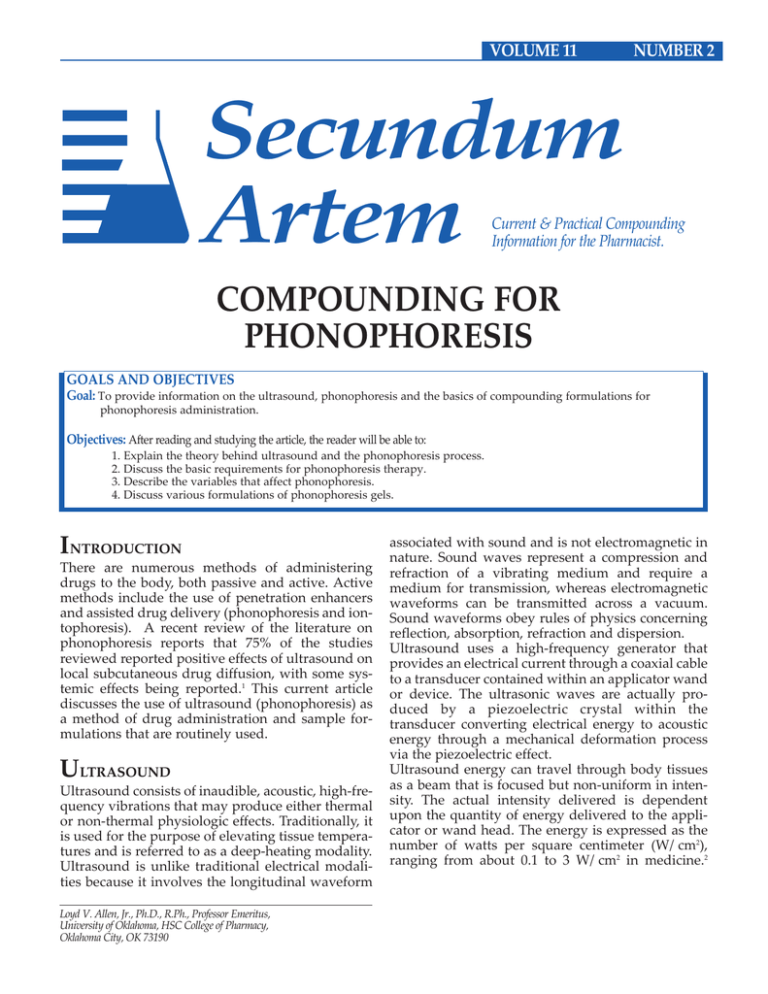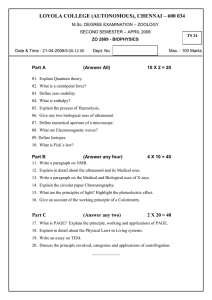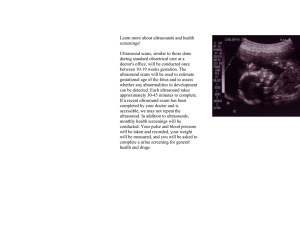COMPOUNDING FOR PHONOPHORESIS
advertisement

VOLUME 11
NUMBER 2
Secundum
Artem
Current & Practical Compounding
Information for the Pharmacist.
COMPOUNDING FOR
PHONOPHORESIS
GOALS AND OBJECTIVES
Goal: To provide information on the ultrasound, phonophoresis and the basics of compounding formulations for
phonophoresis administration.
Objectives: After reading and studying the article, the reader will be able to:
1. Explain the theory behind ultrasound and the phonophoresis process.
2. Discuss the basic requirements for phonophoresis therapy.
3. Describe the variables that affect phonophoresis.
4. Discuss various formulations of phonophoresis gels.
INTRODUCTION
There are numerous methods of administering
drugs to the body, both passive and active. Active
methods include the use of penetration enhancers
and assisted drug delivery (phonophoresis and iontophoresis). A recent review of the literature on
phonophoresis reports that 75% of the studies
reviewed reported positive effects of ultrasound on
local subcutaneous drug diffusion, with some systemic effects being reported.1 This current article
discusses the use of ultrasound (phonophoresis) as
a method of drug administration and sample formulations that are routinely used.
ULTRASOUND
Ultrasound consists of inaudible, acoustic, high-frequency vibrations that may produce either thermal
or non-thermal physiologic effects. Traditionally, it
is used for the purpose of elevating tissue temperatures and is referred to as a deep-heating modality.
Ultrasound is unlike traditional electrical modalities because it involves the longitudinal waveform
Loyd V. Allen, Jr., Ph.D., R.Ph., Professor Emeritus,
University of Oklahoma, HSC College of Pharmacy,
Oklahoma City, OK 73190
associated with sound and is not electromagnetic in
nature. Sound waves represent a compression and
refraction of a vibrating medium and require a
medium for transmission, whereas electromagnetic
waveforms can be transmitted across a vacuum.
Sound waveforms obey rules of physics concerning
reflection, absorption, refraction and dispersion.
Ultrasound uses a high-frequency generator that
provides an electrical current through a coaxial cable
to a transducer contained within an applicator wand
or device. The ultrasonic waves are actually produced by a piezoelectric crystal within the
transducer converting electrical energy to acoustic
energy through a mechanical deformation process
via the piezoelectric effect.
Ultrasound energy can travel through body tissues
as a beam that is focused but non-uniform in intensity. The actual intensity delivered is dependent
upon the quantity of energy delivered to the applicator or wand head. The energy is expressed as the
number of watts per square centimeter (W/cm2),
ranging from about 0.1 to 3 W/cm2 in medicine.2
CE No Longer
Available for
This issue
Quest Educational Services Inc. is accredited by the
Accreditation Council for Pharmacy Education as a
provider of continuing pharmaceutical education.
ACPE No. 748-999-02-061-H04 (0.1 CEU)
This lesson is no longer valid for CE credit after 11/01/05.
The ultrasound emitted from the unit is actually
sound waves that are outside the normal human
hearing range. The ultrasonic unit sound transducer
head is generally set to emit energy at 1 MHz at 0.5
to 1 W/cm2. As ultrasound waves, they can be
reflected, refracted and absorbed by the medium,
just like regular sound waves.
Ultrasound can induce four basic physiologic effects
in the body, including chemical reactions, biologic
responses, mechanical responses and thermal effects.
Enhancement of chemical reactions by ultrasound
can result in enhanced healing. Biologic responses
are enhanced when ultrasound increases the transfer
of fluids and nutrients into the tissues. Mechanical
responses involve cavitation and tendon extensibility and the thermal effects include treatment referred
to as ultrasonic diathermy.
Ultrasound has been indicated in tissue healing,
acute and chronic inflammation, joint contractures,
muscle spasm, scar tissue, trigger points, myositis
ossificans and plantar warts. Due to potential heat
buildup, ultrasound can be administered in a pulsed
mode, rather than continuous. The use of pulsed
ultrasound results in a reduced average heating of
the tissues. Interestingly enough, either pulsed or
continuous low intensity ultrasound can produce
nonthermal or mechanical effects that are associated
with soft-tissue healing.
Another modality should be mentioned for completeness; that of infrasonic therapy. Normal human
hearing is in the range of 60 to 20,000 Hz; ultrasound
uses the frequencies of 3 and 5 MHz; infrasound uses
oscillations below the hearing range, at 8 to 14 Hz.
Infrasound is used primarily as a therapeutic massage modality.
PHONOPHORESIS
When ultrasound is used to drive molecules of a topically applied medication, it is called phonophoresis.
Iontophoresis primarily involves delivery of "ions"
(as well as some molecules through the process of
electroendoosmosis)
whereas
phonophoresis
involves the delivery of "molecules". Although the
exact mechanism is not known, drug absorption
may involve a disruption of the stratum corneum
lipids allowing the drug to pass through the skin.
Phonophoresis (therapeutic ultrasound, sonophoresis, ultrasonophoresis, ultraphonophoresis) is
actually a combination of ultrasound therapy with
topical drug therapy to achieve therapeutic drug
concentrations at selected sites in the skin. It is widely used by physiotherapists. Generally, it is said that
phonophoresis will result in greater depth of penetration than iontophoresis; ultrasound waves have
been reported to penetrate up to 4 to 6 cm into the
tissues. Both pulsed and continuous ultrasound are
used in phonophoresis.
Phonophoresis is commonly used in the treatment of
muscle soreness, tendonitis and bursitis.
DRUG APPLICATION
Two different approaches are used for actual drug
delivery. Originally, the drug-containing coupling
agent was applied to the skin immediately followed
by the ultrasound treatment. Today, generally the
product is applied to the skin and a period of time
allowed for the drug to begin absorption into the
skin; then, the ultrasound is applied. Drug penetration is most likely in the 1 to 2 mm depth range.2
C
ONTRAINDICATIONS
Contraindications and/or precautions for the use of
ultrasound and phonophoresis include infection,
cancer, heart problems/pacemaker, implants (metal,
silicone, saline), acute and post-acute injury, epiphyseal areas, pregnancy, thrombophlebitis, impaired
sensation and around the eyes.
COUPLING MEDIUM
A coupling medium is required to provide an airtight contact between the skin and the ultrasound
head. The coupling medium should form a slick,
low-friction surface for the ultrasound head to glide
over. In phonophoresis, the coupling medium can
also serve as the drug vehicle. Agents used as coupling media include mineral oil, water-miscible
creams and gels. The pseudoplastic rheology flow
exhibited by gels is advantageous as gels are "shearthinning", decreasing viscosity and friction when
stress is applied.
In the immersion method, water is the best medium.
The immersion method is best used for areas that
are small or irregularly shaped. In this method, the
drug is applied in a suitable vehicle prior to immersion into water and the application of the
ultrasound.
VARIABLES
Variables involved in phonophoresis include energy
levels, cavitation, microstreaming, coupling efficiency and transmissivity of the vehicle, extent of skin
hydration, use of an occlusive dressing post-treatment and type of drug.
Energy levels are attenuated as the ultrasound
waves are transmitted through the tissues due to
either absorption of the energy by the tissues or by
dispersion and scattering of the waves. Ultrasound
used for therapeutics is generally in the frequency
range between 0.75 and 3.0 MHz; 1 MHz is transmitted through the more superficial tissues into the
deeper tissues (3-5 cm) and is more useful in individuals with a higher percent of body fat and 3 MHz
energy is absorbed more in the superficial tissues (12 cm). Delivery of ultrasound can be either
thermal-continuous (producing more thermal heating; intensity of 1.0 to 1.5 W/cm2 for 5-7 minutes) or
nonthermal-pulsed (producing less heating; 0.8 to
1.5 W/cm2 with a duty cycle of 20%-60% for 5-7
minutes). Another variable affecting dosage is the
energy of application; 0.1 to 0.3 W/cm2 is regarded
as low intensity, 0.4 to 1.5 W/cm2 is medium intensity and 1.6 to 3 W/cm2 is high intensity; treatment
times generally range from 5 to 10 minutes.3
Effects produced by ultrasound, other than heating,
include cavitation and acoustic micro-streaming.
Cavitation involves the formation and collapse of
very small air bubbles in a liquid in contact with
ultrasound waves due to the pressure changes
induced in the tissue fluids. Cavitation can actually
cause an increased fluid flow around these vibrating "bubbles".
Microstreaming, closely associated with cavitation,
results in efficient mixing by inducing eddies in
small volume elements of a liquid; this may
enhance dissolution of suspended drug particles
resulting in a higher concentration of drug near the
skin for absorption. It is actually a movement of fluids in one direction along cell boundaries that
results from the mechanical pressure wave in an
ultrasonic field. Microstreaming can alter the structure of the cell membrane and it’s function as a
result of changes in permeability to sodium and
calcium ions. Ultrasound apparently also contributes to protein synthesis, fibroblastic activity,
blood flow, vascular permeability and decreased
edema. The amount of drug absorbed is related to
the amount of protein in the tissues, water content
of tissues and the frequency and intensity of the
ultrasound resulting in increased molecular
motion.
The actual tissue penetration also is dependent
upon the impedance or acoustic properties of the
media or the efficiency of the coupling agent. The
vehicle containing the drug must be formulated to
provide good conduction of the ultrasonic energy
to the skin. The product must be smooth and nongritty as it will be rubbed into the skin by the head
of the transducer. The product should be of relatively low viscosity for ease of application and ease
of movement of the transducer head during the
ultrasound process. Gels work very well as a medium. Emulsions have been used but the oil:water
interfaces in emulsions can disperse the ultrasonic
waves, resulting in a reduction of the intensity of
the energy reaching the skin. It may also cause
some localized heating. Air should not be incorporated into the product as air bubbles may disperse
the ultrasound waves resulting in heating at the liquid:air interface.
APPLICATION
For greater efficiency of both the ultrasound and
phonophoresis, the skin should be will hydrated.
Lack of moisture impedes sound transfer; the skin can
be rehydrated using a warm, moist towel for about 1015 minutes prior to the treatment. After treatment is
completed, an occlusive dressing will help to maintain
skin hydration, warmth and capillary dilatation; it will
also keep the drug (residing on the skin surface) in intimate contact with the skin for further absorption.
There are numerous steps involved in successful treatment using phonophoresis, as follows:
1. Determine if phonophoresis is indicated and that no
contraindications are present.
2. Clean and hydrate (if necessary) the body part.
3. Determine the drug to be used.
4. Determine the coupling method {direct (determine
coupling agent) or water immersion} to be used.
5. Determine the frequency.
6. Determine the intensity.
7. Determine the time of treatment.
8. Start treatment.
9. If local, move the sound head at approximately 4
cm/sec, with an overlap one-half the width of the
sound head.
10. Determine the number of treatments per day.
11. Record the necessary parameters.
12. Clean the unit and the treated area.
13. Apply an occlusive dressing if desired.
In summary, drug delivery can be maximized by controlling these variables. According to a phonophoresis
research review1, special attention should be to the following:
1. Both the drug and the coupler (or vehicle) should
efficiently transmit ultrasound.
2. Pretreat the skin using ultrasound, heat, moisture
or by shaving.
3. Position the patient to maximize circulation during
treatment.
4. Use an occlusive dressing after treatment.
5. Use an intensity of 1.5 W/cm2 to capture both the
thermal and non-thermal effects of the ultrasound.
6. Low-intensity ultrasound (0.5 W/cm2) should be
used when treating open wounds or acute injuries.
DRUGS USED
Numerous drugs have been administered using
phonophoresis. Hydrocortisone is the drug most often
administered using phonophoresis in concentrations
ranging from 1% to 10%. Other drugs administered
include betamethasone dipropionate, chymotrypsin
alpha, dexamethasone, fluocinonide, hyaluronidase,
iodine, ketoprofen, lidocaine, mecholyl, naproxen,
piroxicam, sodium salicylate, trypsin, and zinc.
PHONOPHORESIS FORMULAS
Rx
Ultrasound Gels
Carbopol 940
(0.65%)
Hydroxy ethylcellulose (3%)
Methylcellulose 4000 cps
Propylene glycol
Methylparaben
Sodium hydroxide 10% solution
Purified water
qs
Carbopol-Type
650 mg
--5 mL
200 mg
qs
100 mL
HEC-Type
-3g
-5 mL
200 mg
-100 mL
MC-Type
--3.5 g
5 mL
200 mg
-100 mL
METHOD OF PREPARATION
1. Calculate the required quantity of each ingredient for the total amount to be prepared.
2. Accurately weigh/measure each ingredient.
3. Dissolve the methylparaben in the propylene glycol.
4. Add the solution to about 90 mL of the purified water.
Carbopol Gel
5. Disperse the Carbopol 940 in the solution using rapid agitation.
6. Slowly, add about 1.5 mL of the sodium hydroxide 10% solution.
7. Mix slowly to form a smooth gel and avoid incorporating air into the product.
8. Slowly, add additional sodium hydroxide 10% solution until a pH of 6.5-7 is obtained.
9. Add sufficient purified water to volume and carefully mix.
10. Package and label.
Hydroxy Ethylcellulose (HEC) and Methylcellulose (MC) Gels
5. Initially, disperse the hydroxy ethylcellulose or methylcellulose in the solution using moderate agitation.
6. Then, mix slowly to form a smooth gel and avoid incorporating air into the product.
7. Add sufficient purified water to volume and carefully mix.
8. Package and label.
Rx
Corticosteroid Gels for Phonophoresis
Betamethasone
Dipropionate
0.05% Gel
Active drug
77 mg (Equiv to
50 mg betamethasone)
Propylene glycol
qs
Ultrasound Gel qs
100 g
Dexamethasone
sodium phosphate
0.4% Gel
528 mg (Equiv to
400 mg dexamethasone)
qs
100 g
Fluocinonide
0.1% Gel
100 mg
qs
100 g
Hydrocortisone
10% Gel
10 g
qs
100 g
METHOD OF PREPARATION
1. Calculate the required quantity of each ingredient for the total amount to be prepared.
2. Accurately weigh/measure each ingredient.
3. Mix the corticosteroid powder with sufficient propylene glycol to form a smooth paste.
4. Carefully, add the ultrasound gel without incorporating air into the product.
5. Mix until uniform.
6. Package and label.
Rx
NonSteroidal Anti-inflammatory Gels for Phonophoresis
Ketoprofen
Naproxen
2% Gel
5% Gel
Active drug
2g
5g
Propylene glycol
qs
qs
Ultrasound Gel qs
100 g
100 g
Piroxicam
0.5% Gel
500 mg
qs
100 g
METHOD OF PREPARATION
1. Calculate the required quantity of each ingredient for the total amount to be prepared.
2. Accurately weigh/measure each ingredient.
3. Mix the NSAID powder with sufficient propylene glycol to form a smooth paste.
4. Carefully, add the ultrasound gel without incorporating air into the product.
5. Mix until uniform.
6. Package and label.
Sodium Salicylate
10% Gel
10 g
qs
100 g
Rx DEXAMETHASONE 1.5% AND LIDOCAINE
HCl 4% ULTRASOUND GEL
Dexamethasone sodium phosphate
1.98 g
(Equiv to 1.5 g dexamethasone)
Lidocaine hydrochloride
4g
Propylene glycol
10 mL
Hydroxy Ethylcellulose Ultrasound Gel qs 100 g
METHOD OF PREPARATION
1.Calculate the required quantity of each ingredient for the total amount to be prepared.
2.Accurately weigh/measure each ingredient.
3.Mix the powders with the propylene glycol to
form a smooth mixture.
4.Carefully, add the ultrasound gel without
incorporating air into the product.
5.Mix until uniform.
6.Package and label.
RX IODINE ULTRASOUND OINTMENT
Iodine
4g
Oleic acid
5 mL
White petrolatum
qs
100 g
NOTES__________________________________
___________________________________________
___________________________________________
___________________________________________
___________________________________________
___________________________________________
___________________________________________
___________________________________________
___________________________________________
___________________________________________
___________________________________________
___________________________________________
METHOD OF PREPARATION
1.Calculate the required quantity of each ingredient for the total amount to be prepared.
2.Accurately weigh/measure each ingredient.
3.Dissolve the iodine in the oleic acid.
4.Incorporate the white petrolatum and stir until
uniform.
5.Package and label. Protect from light.
___________________________________________
___________________________________________
___________________________________________
___________________________________________
___________________________________________
Rx ZINC OXIDE 20% GEL
Zinc oxide
Pluronic F127 30% gel
20 g
80 g
METHOD OF PREPARATION
1.Calculate the required quantity of each ingredient for the total amount to be prepared.
2.Accurately weigh/measure each ingredient.
3.Add the zinc oxide powder, previously comminuted, in small portions to the Pluronic F127
Gel.
4.Mix until uniform being careful not to incorporate air into the product.
5.Package and label.
REFERENCES
1. Byl NN. The use of ultrasound as an enhancer
for
transcutaneous
drug
delivery:
Phonophoresis. Phys Ther. 1995;75:539-553.
2.Kahn J. Principles and Practice of Electrotherapy, 4 Ed. Philadelphia PA. Churchill
Livingstone. 2000. pp 63.
3.Prentice WE, Voight ML. Techniques in Musculoskeletal
Rehabilitation.
New
York.
McGraw-Hill. 2001. pp 291-292, 299, 302.
___________________________________________
___________________________________________
___________________________________________
___________________________________________
___________________________________________
___________________________________________
___________________________________________
___________________________________________
___________________________________________
___________________________________________
___________________________________________
___________________________________________
___________________________________________

